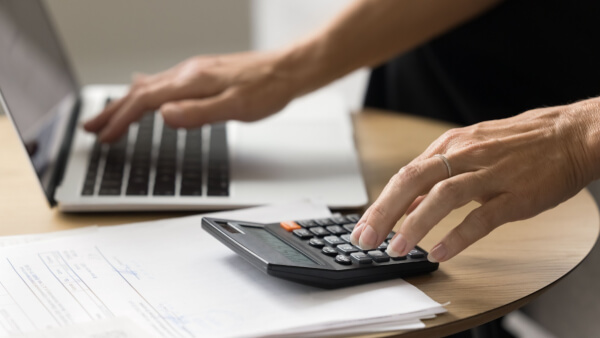New year, new steer? Key takeaways from our end-of-year event with SeedLegals
Earlier this month, we hosted a festive end-of-year event with our partners at SeedLegals. The evening brought together an inspiring group of founder and...

If you’re setting up a business as a sole trader, you’ll need to get to grips with invoicing. It can be tricky at first, as you establish your own process and make sure you include everything that your client requires.
As your business grows and you have more clients, you’ll also need to find ways to streamline the invoicing process. Luckily, there are tools available to help.
In this guide, we’ll run through all the essentials you need to know about invoicing as a sole trader. This includes how to create an invoice, what to include and some info on invoicing international clients from the UK.
We’ll also touch on an easy way to get paid in any currency, with a Wise Business account.
💡Learn more about Wise Business
As a UK sole trader, invoicing is just as important a part of running your business as the products and services you provide.
Not only does it ensure you get paid, but it’s also required by law - if you and your client are registered for Value Added Tax (VAT). Once you sell a product or service to a customer, you’re legally obligated to give them an invoice.
Even if you’re not registered for VAT (if your annual income falls under the threshold for VAT, for instance), it’s still good practice to issue prompt invoices after providing your services.
An invoice can be a simple document created using your word processing software, or you can create them through business tools. For example, you can quickly and easily generate invoices with Xero, or other accounting tools such as Sage or Quickbooks.
It doesn’t matter how you create an invoice as long as the key information is included. We’ll cover key invoicing details next.
There are certain things that must be included on a sole trader invoice in the UK. Some are essential for yours and your client’s record-keeping and accounting requirements, and to ensure you get paid properly. Others are legally required, especially if you’re VAT-registered and must issue invoices by law.
Here are the basic details that must be invoiced on a UK invoice:¹
It’s also crucial to include the date you expect the invoice to be paid, according to your payment terms agreed between you and your client.
And of course, you should include your full payment details. You’ll likely want to include your bank details or Wise Business account details (only with Wise Business Advanced) on all invoices, but may also mention other options if you accept payment in different forms.
💡Learn more about Wise Business
Now, let’s move on to how to write an invoice in the UK. If it’s your first one, it’s a good idea to use an invoice template suitable for your line of work. Wise has a free invoice template available to download and use here.
It’s a little more complicated to invoice clients based in other countries. Firstly, you need to check whether your international clients have any particular requirements when it comes to the invoicing process.
There may be details you need to pay extra attention to due to the regulations in their country. For example, when invoicing EU customers from the UK, you need to adhere to EU regulations.
You also need to make sure you’re invoicing in the right currency. This is something you’ll need to agree with your client in advance, if you both have different currencies in your respective home countries.
One easy way to get paid by clients in different currencies is with a specialist solution such as Wise Business.
When you sign up with Wise, you’ll receive local bank details in multiple major currencies such as EUR and USD. Then all you need to do is provide the right details (depending on where your client is based) on your invoice. Your client can pay you in their own currency, just like you’re also based in their country.

You can then convert the funds to GBP for a small fee and at the mid-market exchange rate, leave it in your Wise Business balance to earn you a return, or use it for other business expenses.
You can even request payments by sharing a payment link with your client. It’s the quick, easy and cost-effective way to get paid as a UK sole trader with international clients.
Get started with Wise Business 🚀
Timing is everything with invoicing, especially when you’re a sole trader. You need to agree payment terms with your client before you start work, so that everyone is on the same page. This is essentially how long your client has to pay after an invoice has been issued, and the payment method they’ll use.
It’s very important to invoice promptly after providing goods or services, so that you can be paid on time.
Email is one of the most common ways to send over an invoice, but you can also generate and issue them automatically using accounting software.
The email only has to be brief, including the key facts such as the invoice number and due date.
Hi [Recipient name],
Please see attached invoice number [invoice number] for [product/service name], due for payment by [invoice due date]. Please feel free to get in touch if you have any questions. Thanks in advance for prompt payment.
Kind regards,
[Sender name]
Wise Business is the ideal solution for sole traders in the UK to manage their business finances with ease. If you do any business internationally, Wise can make it easier and more cost-effective to get paid in multiple currencies.
With your Wise Business account, you can invoice and request payment in just a few clicks. Your client can pay in their preferred currency, and you can convert the funds back to your own currency for just a low fee. Best of all, you’ll be able to do all conversions at mid-market exchange rates, which is better than most banks.
This means you get to keep more of your hard-earned money.
You can use Wise Business to send payments worldwide, and spend on your own Wise international debit card. You can also integrate it seamlessly with your accounting tools using the powerful Wise open API.
Get started with Wise Business 🚀
Please see Terms of Use for your region or visit Wise Fees & Pricing for the most up to date pricing and fee information.
After reading this guide, you should be all set to create your first invoice as a sole trader. You’ll now know how to get started, what key details to include and how to get paid in any currency.
Sources used:
Sources last checked on date: 11-Sep-2023
*Disclaimer: The UK Wise Business pricing structure is changing with effect from 26/11/2025 date. Receiving money, direct debits and getting paid features are not available with the Essential Plan which you can open for free. Pay a one-time set up fee of £50 to unlock Advanced features including account details to receive payments in 22+ currencies or 8+ currencies for non-swift payments. You’ll also get access to our invoice generating tool, payment links, QuickPay QR codes and the ability to set up direct debits all within one account. Please check our website for the latest pricing information.
*Please see terms of use and product availability for your region or visit Wise fees and pricing for the most up to date pricing and fee information.
This publication is provided for general information purposes and does not constitute legal, tax or other professional advice from Wise Payments Limited or its subsidiaries and its affiliates, and it is not intended as a substitute for obtaining advice from a financial advisor or any other professional.
We make no representations, warranties or guarantees, whether expressed or implied, that the content in the publication is accurate, complete or up to date.

Earlier this month, we hosted a festive end-of-year event with our partners at SeedLegals. The evening brought together an inspiring group of founder and...

Learn what business process automation is and how it can transform your operations. Discover key benefits and how to get started with BPA.

Read our comprehensive Sokin multi-currency account review for UK business customers, including pros, cons and features.

Looking for the best business accounts in Northern Ireland? Compare fees, features and benefits to find the account that supports your business best.

Find the best team collaboration tools to boost productivity and streamline communication. Compare features, pricing, and user reviews to choose wisely.

Looking for the best business bank account for landlords in the UK? Read this to compare accounts, providers, features, fees and more.